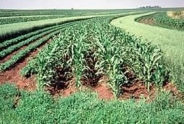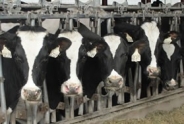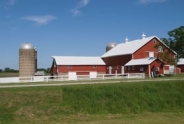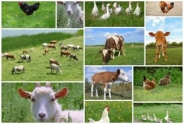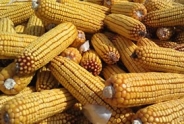If Money Doesn't Grow On Trees - Maybe it Grows in Hay Fields?
,
The original version of this article was published by Katelyn Walley-Stoll on February 21, 2023, and updated by Amy Barkley on June 11, 2025.
If you grow, feed, or sell hay, it's important to know how to manage the green - the money, that is - to make profitable decisions. Hay production, whether it's sold off the farm or fed to livestock, is a key part of many of our farms in SWNY. Producing your own hay can diversify and improve the profitability of your farm. But, hay production can decrease your farm's profitability over time. Not tracking financial and production records can lead to poor decision-making.
All the numbers to justify this topic. Based on the latest Ag Census data (2012), hay production in SWNY is big business. In our five-county region, there were 2,685 farms producing 244,270 acres of hay, haylage, grass silage, and green chop. This is 53% of farms producing some type of hay on 24% of all the SWNY farmland. 612,110 dry equivalent tons of hay crop was produced in 2022.
Based on the 2023 Pro-Dairy Dairy Farm Business Summary, dairy feed and crop expenses per cwt of milk was $9.67 in 2023, which accounted for 41% of the total cost of producing milk. The cost of feed and crops did stay roughly the same from 2022 to 2023, with an $0.18 decrease per cwt. However, 2022 and 2023 prices were significantly higher than feed costs in 2021, which averaged $8.28 per cwt. For livestock producers, the cost of forages on a unit of production basis can range from 20% to 80%!
Still don't believe that hay and forage production on farms is a big deal financially? Take a look at your own farm's numbers. Even if you're not keeping accurate financial data (don't worry, I'll convince you otherwise by the end of this), you can still estimate how much hay production is costing you. Take a look at your latest tax return - on your Schedule F, how much money did you spend on Fertilizers and Lime, Gasoline, Fuel, and Oil, Repairs and Maintenance, Seeds and Plants, etc.? How much of that total, based on your estimate, went towards producing hay this past year? Now…add in your depreciation expense on your hay equipment, interest on any financed equipment, mortgage interest or rent payments for hay ground, and any other costs. Probably a pretty big number, right? And I haven't even asked you to estimate how much of your time/labor you spent making hay!
Why you should produce your own hay. Producing your own hay, from a financial perspective, has many benefits. For one, and probably the biggest consideration, you can control the costs of your own production. An example - if you buy hay for your farm, you're going to have to pay whatever the seller is asking for or keep looking around for a better deal. Producing your own hay, you can control how much you spend and how much you sell it for. Even if you can't control the price of your inputs (I'm looking at you fertilizer and fuel), you can control how much of those inputs you use. If you're selling hay off the farm, you can set your price above your costs to guarantee a profit. If you're feeding hay, you can incorporate the cost of your hay by essentially "selling" the hay to yourself.
Along with controlling the cost and price, you can control the quality to be as efficient as possible. Buying hay is always a risk. You never know what you're going to get and can't always guarantee the quality from bale to bale. Producing your own hay means you know exactly what went into it, when it was harvested, etc. If you're buying high quality hay, you will pay a premium. If you're making your own hay, you know what quality you need and can make input decisions accordingly.
Especially for farms that have more than one enterprise, producing your own hay allows you to spread fixed assets over more production areas. For example, if you have a tractor that you use to spread manure while cows are in the barn during winter, you can also use that tractor to make hay in the summer. This spreads out the fixed cost of owning the tractor but will increase the variable cost of operating the tractor (fuel, maintenance).
Why you shouldn't produce your own hay. While buying hay is risky, so is producing it. For some farms, not making hay is the better option, even if it's very difficult to let go of that control. If you're raising livestock and you're looking to grow or buy hay to feed them, there are several advantages to the latter option. Land that you own, or are renting, to make hay could instead be used for pastures, grain crops, or additional production areas. This is especially important if you're paying high rent/lease fees for ground you do not own, and we're seeing land rent prices steadily rise in our area. If you're paying a high rent price, and can buy hay for cheaper than the cost to pay the rent and produce it, making hay might not be the best fit.
The other big bucket of "stuff" that can be used elsewhere is your time. I can bet that you're not writing yourself a paycheck to make the endless laps around fields, and that's not including the time spent watching the weather, maintaining equipment, and storing or marketing the hay. If there are areas of your farm that are struggling because you don't have enough time in the day to devote to them, removing forage production can help with your time balance. Even if you can produce hay cheaper than you can buy it, could you be making a higher profit elsewhere to make up for the added expense?
Also, equipment is stupid expensive. That's it. That's the paragraph. Even if you're utilizing used equipment, consider maintenance costs. Do you have the expertise to diagnose and fix and maintain your required fleet of hay implements? And if you're using new equipment, can you keep up with financing?
Tools you can use to decide to grow or buy or sell hay. Okay, now that I've justified the importance of this topic and grappled with the "Buy or Grow" decision, let me be actually helpful and give you some resources and ideas to improve your hay production business or purchases. There is no way I can say that there will ever be a correct answer for the decision to buy or make or sell hay. It's so dependent on your farm's unique situation, your goals and resources, etc. But, there are tools you can use to make sure you're making the best decision for your farm.
Calculating your Cost of Production. Cost of Production is a financial analysis tool for farms of all shapes and sizes to use to improve their decision making capacity and operate their farm business profitably. Cost of production is calculated by adding the costs associated with a certain farm enterprise (or production area), and dividing that by the total units of production over a designated time frame (usually a year). For hay production, you would look at costs like fuel, equipment maintenance, supplies and then divide it by the number of bales or total tons of hay you produced. At the end, you would be able to say "It cost me $45 to make a round bale this year".
Knowing your cost of production can help determine breakeven prices for profitability, make cost-saving decisions, find the biggest opportunity for return on investment for your farm, benchmark your performance, and more. You could be the best farmer in the world, doing all of the right things, but if you're not bringing in more money than it costs for you to produce what you're selling, you won't be a sustainable business. Being a good farmer doesn't guarantee success - you also have to be a good business manager and financial analysis is an important process.
The main requirements to calculate a cost of production are good records, time, and motivation. Records should include incomes by value and production unit, expenses and their allocation towards different farm enterprises, an estimate of the value of management labor and skills, and inventories of assets that include feed, supplies, and animals. Successful farmers set aside our most limiting input - time - to perform financial analysis. Having sound numbers can often save you time at the most critical moments! The first time through calculating your cost of production can be frustrating, but the end result is rewarding and future calculations will go much more smoothly! Refer to the example provided for implementing this on your farm.
Using a Partial Budget. Partial budgets are another tool we have to make financially sound decisions for the farm. You can use a partial budget to compare a change to something else, usually the "status quo". These are quick, informal tools that can be used to start a discussion by looking at the financial items that are impacted by a proposed change. Partial budgets also happen to be my favorite thing.
To put together a partial budget you can use an excel spreadsheet, a fillable form from the internet, or my super fancy (not really) example here. You state the decision and name your assumptions. You then identify ways that the proposed change will change your farm's income by reducing costs or increasing revenues. Examples of where partials budgets are really helpful including equipment fixing vs. replacement, hay production vs. buying, market options, manure vs. fertilizer, and much more! Refer to the example provided today for more information.
Looking at Hay Market Prices. A lot of times, I get a phone call that goes something like this:
Caller: Hi, I have hay to sell. How much should I charge?
Me: Hi. How much did it cost you to make it?
Caller: I'm not sure, what's the average price around here?
Me: ….. [long pause].
Why the long pause? Using market prices to sell your hay direct isn't a great tool. Without knowing how much it costs you to make the hay, there is no guarantee that you're not losing money if you set the price too low. Oftentimes, when I work with farms to see what their cost of production actually is, we find that the prices they're selling hay for are actually less than their costs to produce the hay. In this case, they were essentially subsidizing their hay enterprise with their own labor, off-farm income, and shared fuel expense with other enterprises.
That being said, knowing market prices can help you benchmark your prices and decide if buying hay might be a better route for you. There are a few different ways I check on market prices for our region. I'll ask my farm neighbors, local CCE office, local crop places, etc. along with paying attention to the "side of the road" advertised prices. This gives you a hyper-local idea, but can oftentimes be way too low! Other places I look for market prices are using NASS Quick Stats, AMS Hay Market Reports, Auction reports from New Holland, PA and various classified sites (allhay.com and Grassroots in particular).
Recordkeeping and Risk Management. Okay - hopefully I've convinced you that having good records is a great way to determine your cost of production, put together partial budgets, and make financial decisions for your farm. To keep sound financial records, you should set up a record keeping system that works for you (ledger, notebook, excel spreadsheet, QuickBooks, etc.) and monitor the incomes and expenses of the farm. You can also record and track transactions by enterprise to further mark what went towards hay production. You should also keep production records. This includes yield by field by cutting and harvest dates, quality, inventory, and sales records.
Don't forget - you can insure your hay ground with crop insurance. The Pasture, Rangeland, and Forage Insurance Policy makes payments when area-based rainfall amounts fall outside of specified ranges and offers subsidized premiums. Losses are triggered when precipitation levels fall below average for the index interval for your region, and the losses are automatic - you don't need to submit any paperwork and you can postpone premium payments until after the season. You can use RMA's Agent Locator Tool to find a crop insurance agent near you.
Conclusion. The long awaited conclusion. If you've made it this far, it's not that much harder to calculate your hay operation's cost of production! If you realize that you don't have the records you need to do this calculation, set yourself up for success now ahead of this coming season. For assistance, reach out to your local Farm Business Management Specialist. While producing hay on farm, selling hay, or buying hay is a rough decision unique to each operation, it doesn't have to be guesswork!
This article was written as part of Cornell Cooperative Extension's "Diversifying Your Dairy" initiative. This material is based upon work supported by USDA/NIFA under award number 2021-70027-34693. SWNYDLFC is a partnership between Cornell University and the CCE Associations of Allegany, Cattaraugus, Chautauqua, Erie, and Steuben counties. Their team includes Katelyn Miller, Field Crops and Forage Management (716-640-2047); Katie Callero, Dairy Management (607-422-6788); and Amy Barkley, Livestock Management (716-640-0844).
Upcoming Events
Optimizing the Economic Return of Pasture-Raised Slow-Growth and Conventional Broilers - Webinar
November 13, 2025 : Optimizing the Economic Return of Pasture-Raised Slow-Growth and Conventional Broilers - Webinar
Over the past three years, Cornell Cooperative Extension has worked with nearly 40 small farmers across NYS to gather information on the true costs of raising broilers (meat chickens) on pasture. This presentation is a summary of the findings of this research project.
NY Small Farms Summit 2025: Stronger Together
December 5, 2025
Alfred, NY
We hope you will join us on December 5th for the 2025 New York Small Farms Summit! This is an opportunity to meet other farmers and ag supporters, learn about research and education projects, and set priorities for future efforts to grow small farm success.
At the Allegany County site, we will focus on giving trees a chance and how trees build resiliency on small farms. Whether attracted to fruit, nuts, vegetables, fodder or shade, trees can be an integral part of a successful farming system. Join us as we explore the opportunities for resiliency that come from adding tree crops or managing wooded areas of your farm for agroforestry or silvopasture systems.
Crops, Cows & Critters - Southwest New York Dairy, Livestock & Field Crops Newsletter Sponsorship
December 19, 2025
Our two forms of publications feature research-based and timely information from our four specialists, listed to the right, along with local event notifications and Cornell University outreach. This information is provided to participants who range from dairy, livestock, and field crops producers to agricultural suppliers and consultants.
Weekly Email Update: Shared with 625+ households who have signed up with our program.
Monthly Paper Mailer: To reach our stakeholders and farmers who lack internet access, we send out a monthly mailer where your company's logo and contact information would be featured with a mailing list of 330+ households.
If you sponsor our weekly and monthly publications you reach approximately 955 households.
Visit our website to view our newsletters!
Announcements
No announcements at this time.

